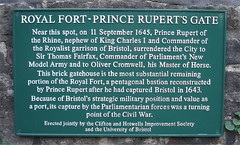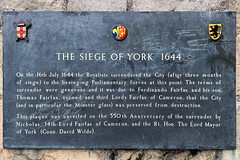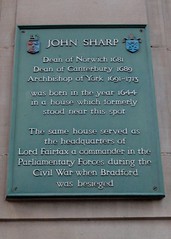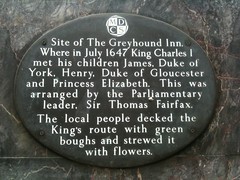Lord General Thomas Fairfax
_by_Robert_Walker_and_studio.jpg?width=250)
_by_Robert_Walker_and_studio.jpg?width=250)
Lord General Thomas Fairfax
(1612-1671)
New Model Army Lord General and 3rd Lord Fairfax of Cameron (from 1648)
Family tree
Commemorated on 7 plaques
Royal Fort - Prince Rupert's Gate. Near this spot, on 11 September 1645, Prince Rupert of the Rhine, nephew of King Charles I and Commander of the Royalist garrison of Bristol, surrendered the City to Sir Thomas Fairfax, Commander of Parliament's New Model Army and to Oliver Cromwell, his Master of Horse. This brick gatehouse is the most substantial remaining portion of the Royal Fort, a pentagonal bastion reconstructed by Prince Rupert after he had captured Bristol in 1643. Because of Bristol's strategic military position and value as a port, its capture by the Parliamentarian forces was a turning point in the Civil War.
Prince Rupert's Gate, Bristol, United Kingdom where they accepted a surrender
Wickham Court Oliver Cromwell and General Fairfax held a Council of War at the house before the attack on Bristol Sept 1645
Wickham Court, Bristol, United Kingdom where they held a Council of War
The Siege of York 1644. On the 16th July 1644 the Royalists surrendered the City (after three months of siege) to the besieging Parliamentary forces at this point. The terms of surrender were generous and it was due to Ferdinando Fairfax and his son, Thomas Fairfax, second and third Lords Fairfax of Cameron, that the City (and in particular the Minster glass) was preserved from destruction. This plaque was unveiled on the 350th Anniversary of the surrender by Nicholas, 14th Lord Fairfax of Cameron, and the Rt. Hon. The Lord Mayor of York (Coun. David Wilde).
2 Blossom Street, York, United Kingdom where they was
John Sharp, Dean of Norwich 1681, Dean of Canterbury 1689, Archbishop of York 1691-1713 was born in the year 1644 in a house which formerly stood near this spot. The same house served as the headquarters of Lord Fairfax a commander in the Parliamentary Forces during the Civil War when Bradford was besieged.
Ivegate, Bradford, United Kingdom where they was headquartered (1642)
Site of The Greyhound Inn Where in July 1647 King Charles I met his children James, Duke of York, Henry, Duke of Gloucester and Princess Elizabeth. This was arranged by the Parliamentary leader, Sir Thomas Fairfax. The local people decked the King's route with green boughs and strewed it with flowers.
66 High Street, Maidenhead, Berkshire, SL6 1PY, Maidenhead, United Kingdom where they arranged the meeting of King Charles I and his children
This stone commemorates the Battle of Maidstone. In this area a parliamentary force under Lord-General Fairfax, defeated the royalist defenders of Maidstone under Sir Gamaliel Dudley in one of the hardest fought battles of the English Civil War. 1st June 1648.
Bank Street, Maidstone, United Kingdom where they fought (1648)
Formerly The Assembly Room King's Head Inn In this room the Royalist Officers surrendered on the conclusion of the Siege of Colchester. August 27th 1648
Headgate Court, Head Street, Colchester, United Kingdom where they accepted a surrender (1648)







